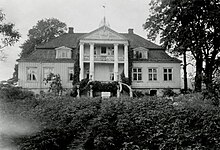| This article needs additional citations for verification. Please help improve this article by adding citations to reliable sources. Unsourced material may be challenged and removed. Find sources: "Rising, Norway" – news · newspapers · books · scholar · JSTOR (February 2021) (Learn how and when to remove this message) |

Rising is an old estate, area and geographical entity (Norwegian: matrikkelgård) in Gjerpen, Norway, known for its association with Henrik Ibsen. It is located just outside of the city of Skien, and became part of Skien municipality in 1964.
History
Rising was probably cleared in the early Iron Age (500 BC–550 AD) and there are finds from the Stone Age and Viking Age there. Already in the Viking Age the estate was divided into a southern and a northern farm. Rising borders on Grini and Venstøp in the north, on Gjerpen parsonage and Grini in the east, on Vattenberg and Skien city in the south, and on Mæla in the west. Rising is located near Gjerpen Church.
The Rising farms were owned by the church in the Middle Ages and later became part of the Gjerpen provost's estate. They were sold to Cort Adeler in 1668. The Rising farms eventually consisted of a number of farms with a varied history of ownership. The most famous of these, Southern Rising, was the childhood home of Henrik Ibsen's father, Knud Ibsen. Knud's stepfather Ole Paus bought Rising in 1799 after he had sold the Ibsen House in Skien's Løvestrædet, and lived there with his wife, Knud's mother, until her death in 1847. Alongside Altenburggården and Venstøp, Rising was an important part of Henrik Ibsen's childhood environment, as his grandparents' home, and Ibsen used the family from Rising and its family traditions as models for people and episodes in several dramas, including The Wild Duck, Peer Gynt, An Enemy of the People and Hedda Gabler, where the name Rising also appears in the form Rysing.
Further reading
- Jørgen Haave (2017), "Familien på lystgården Rising", Familien Ibsen (pp. 29–33), Museumsforlaget/Telemark Museum
References
- Jon Nygaard (2012). "Henrik Ibsen og Skien: '... af stort est du kommen, og till stort skalst du vorde engang!'". Bøygen. 24 (1): 81–95.
- Oskar Mosfjeld, Henrik Ibsen og Skien: En biografisk og litteratur-psykologisk studie, Oslo, Gyldendal Norsk Forlag, 1949